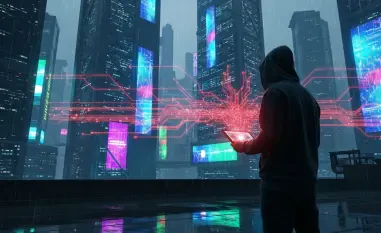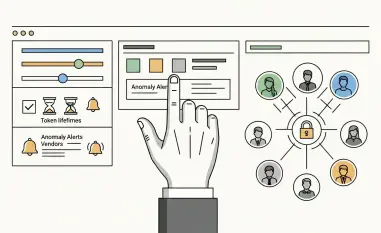In an era where digital infrastructure underpins global economies, a staggering 358% surge in Distributed Denial-of-Service (DDoS) incidents in the first quarter of this year compared to last year, as reported by Cloudflare, paints a chilling picture of escalating cyber threats. This dramatic increase signals not just a rise in frequency but a profound shift in sophistication, driven by artificial intelligence (AI). Businesses, governments, and critical services face unprecedented risks as attackers wield AI to craft precision-guided assaults that bypass traditional defenses with alarming ease. This report delves into how AI is reshaping the nature of DDoS attacks, the challenges in countering these evolved threats, and the innovative strategies required to safeguard digital ecosystems in this rapidly changing landscape.
Understanding the Current State of DDoS Attacks
DDoS attacks have long been a scourge in cybersecurity, disrupting online services by overwhelming servers with malicious traffic. Today, they represent a critical threat to business continuity, with impacts ranging from financial losses to eroded customer trust. As digital transformation accelerates, the reliance on interconnected systems amplifies the potential damage of such disruptions, making DDoS a top concern for organizations worldwide.
Key players in this space include both malicious actors, who exploit advanced tools to orchestrate attacks, and defenders like MazeBolt Technologies, which focus on pioneering mitigation solutions. The battlefield is dynamic, with attackers constantly innovating to exploit vulnerabilities in sprawling digital infrastructures. Meanwhile, defenders scramble to keep pace, often finding themselves outmaneuvered by the sheer adaptability of modern threats.
Technological advancements, particularly AI, have introduced a paradigm shift in attack methodologies. No longer confined to brute-force tactics, DDoS campaigns now leverage intelligent algorithms to target weaknesses with surgical precision. This evolution underscores the urgent need for a deeper understanding of how AI is redefining both the threat and the response mechanisms within the cybersecurity industry.
The Role of AI in Redefining DDoS Threats
Emerging Trends in AI-Driven Attacks
AI has fundamentally altered the approach of DDoS attackers, moving away from sheer volume-based floods toward adaptive, targeted strategies. By harnessing machine learning, malicious actors can analyze vast datasets to identify infrastructure weak points in real time, enabling reconnaissance that is both swift and precise. This intelligence allows for attacks that are not only harder to predict but also more devastating in their impact.
Specific tactics powered by AI include dynamic vector switching, where attackers shift between different attack methods to evade detection, and legitimacy mimicry, which disguises malicious traffic as normal user behavior. Additionally, multi-layered assaults that combine various attack types across network layers further complicate mitigation efforts. These methods exploit gaps in traditional security, rendering many legacy systems obsolete against such sophisticated threats.
The growing complexity of these AI-driven assaults poses significant challenges for detection and response. Unlike earlier attacks that followed predictable patterns, today’s threats adapt on the fly, learning from defensive countermeasures to refine their approach. This cat-and-mouse game places immense pressure on organizations to evolve their defenses at a pace matching or exceeding that of their adversaries.
Statistical Insights and Industry Impact
Data from Cloudflare highlights the scale of the challenge, with a reported 358% increase in DDoS incidents in the first quarter of this year compared to the same period last year. Even more concerning is the 53% rise in attacks leading to production downtime, illustrating how AI optimizes disruption with minimal effort from attackers. These figures reflect a qualitative leap in attack efficacy, not just a numerical uptick.
The industry impact of these trends is profound, as organizations across sectors face heightened risks of operational paralysis. Financial institutions, e-commerce platforms, and critical infrastructure providers are particularly vulnerable, with downtime translating into immediate revenue losses and long-term reputational damage. The ability of AI to streamline attacks means even smaller-scale operations can inflict disproportionate harm.
Looking ahead, these statistics signal an escalating threat landscape that demands immediate attention. As AI continues to empower attackers with smarter tools, the potential for widespread disruption grows. Organizations must brace for a future where such incidents are not anomalies but routine challenges, necessitating robust, forward-thinking strategies to mitigate risks on a global scale.
Challenges in Combating AI-Enhanced DDoS Attacks
Traditional defense mechanisms, often rooted in reactive security postures, struggle to address the agility of AI-enhanced DDoS attacks. Many systems are designed to respond only after an attack begins, leaving little room for preemption. Sporadic testing, such as annual assessments, further compounds the issue by failing to account for the constant evolution of threats.
Research from MazeBolt reveals a sobering reality: even after conventional testing, 37% of enterprise attack surfaces remain vulnerable. This statistic underscores the inadequacy of point-in-time evaluations in a threat environment where attackers continuously probe for weaknesses. Misconfigurations in network settings and untested assets often provide easy entry points for AI-driven exploits.
The expanded digital attack surface of modern enterprises adds another layer of complexity. Hybrid cloud environments, numerous public-facing IPs, and interconnected applications create vast areas that often go untested. Without continuous validation across the entirety of this surface, organizations remain exposed to risks that AI can exploit with pinpoint accuracy, highlighting the need for innovative, ongoing approaches to close these operational gaps.
Regulatory Pressures and Compliance Requirements
Regulatory frameworks are increasingly shaping the cybersecurity landscape, with mandates like the Digital Operational Resilience Act (DORA) in the EU, the Network and Information Security Directive (NIS2) in the EU, and SEC cybersecurity rules in the US placing stringent demands on organizations. These regulations require demonstrable DDoS risk management, pushing companies to adopt active mitigation strategies as a core component of compliance.
Non-compliance carries severe consequences, from hefty legal penalties to significant reputational damage, particularly in regulated sectors like finance and healthcare. The failure to protect against DDoS attacks can erode stakeholder trust and invite scrutiny from authorities, amplifying the stakes beyond mere technical concerns. These frameworks signal a shift toward viewing cybersecurity as a legal imperative, not just a technical one.
The intersection of cybersecurity and compliance drives the adoption of advanced defense mechanisms. Organizations must align their strategies with regulatory expectations, ensuring that evidence of proactive testing and mitigation is readily available. This convergence emphasizes the importance of integrating robust DDoS protections into broader governance and risk management practices to meet both operational and legal standards.
The Future of DDoS Defense in an AI-Driven Era
As AI continues to empower attackers with smarter, more adaptive tactics, the trajectory of DDoS threats points to even greater sophistication. Predictive algorithms could enable preemptive strikes, while deeper integration of machine learning might allow attacks to evolve in real time against even the most dynamic defenses. This outlook suggests a future where staying ahead of threats will require equally advanced technological countermeasures.
On the defensive side, AI and automation hold immense potential to transform protection strategies. Continuous, non-disruptive validation of attack surfaces offers a way to identify and remediate vulnerabilities before they are exploited. Solutions like MazeBolt’s RADAR™ platform exemplify this approach, providing real-time vulnerability management and prioritized remediation guidance without impacting live operations.
Industry frameworks such as Gartner’s Continuous Threat Exposure Management (CTEM) are likely to shape future strategies by advocating for full visibility and ongoing risk assessment. Combined with global economic conditions and rapid innovation, these influences will drive the cybersecurity landscape toward more integrated, automated defenses. Organizations that embrace these trends will be better positioned to navigate the complexities of an AI-driven threat environment over the coming years.
Conclusion: Adapting to an AI-Transformed Threat Landscape
Reflecting on the insights gathered, it becomes evident that AI has redefined DDoS attacks, elevating their sophistication and amplifying their impact across industries. The inadequacy of traditional defenses stands out as a critical barrier, with static measures failing to match the adaptability of modern threats. This gap underscores an urgent need for a shift in approach, which many organizations have begun to recognize.
Looking back, the exploration of continuous, automated testing emerges as a pivotal solution that has gained traction. Adopting platforms capable of real-time vulnerability management offers a practical path to resilience. Enterprises that have prioritized such investments find themselves better equipped to handle evolving risks.
Moving forward, a strategic focus on AI-ready defenses is deemed essential. Building partnerships with technology providers and aligning with industry frameworks has proven effective for those who acted early. The journey ahead demands sustained commitment to innovation, ensuring that operational stability and regulatory compliance remain achievable goals in an ever-shifting digital battleground.













